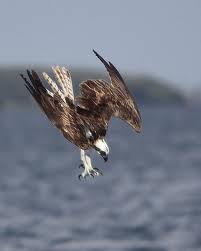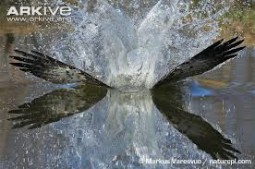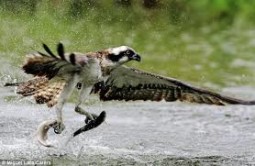
Ospreys carry fish head first.
Ospreys are hunters, or, more accurately, fishers. They are birds of prey, after all. Other birds of prey, like eagles, hawks, falcons, and owls, hunt a variety of other critters, which helps keep an ecosystem in balance. They may eat mice, rabbits, snakes, fish, and even other birds. But ospreys are very picky – they only eat fish.
It’s thrilling to watch an osprey fishing: to see him soaring hundreds of feet above the water, then tuck in his wings and dive. At the  last possible moment, he will swing his open talons forward and splash into the water feet first. He may be completely submerged. He could dive as far as 1 metre (3 feet) below the surface to grasp a fish. And when he comes up, getting himself and the fish out of the water takes a Herculean effort. He’s soaking wet. The fish may weigh almost one third of his own body weight. And it’s wiggling. Swooping a mouse out of the grass seems simple, by comparison.
last possible moment, he will swing his open talons forward and splash into the water feet first. He may be completely submerged. He could dive as far as 1 metre (3 feet) below the surface to grasp a fish. And when he comes up, getting himself and the fish out of the water takes a Herculean effort. He’s soaking wet. The fish may weigh almost one third of his own body weight. And it’s wiggling. Swooping a mouse out of the grass seems simple, by comparison.
But the osprey has several adaptations that increase his chance of success:
Talons are essential. These are long, curved claws used for grabbing and killing his prey, or for aggressively defending his nest. The osprey’s feet aren’t smooth – the skin is nubbly and rough, which helps him keep a grip on a wiggly, slippery fish. His ‘reversible’ outer toe is a lot like your thumb. It can swing around so two toes face back and two face front, providing a more secure grip, which is necessary for the long flight  back to the nest, while possibly fending off thieves.
back to the nest, while possibly fending off thieves.
Oily feathers help the osprey repel water. If an eagle is pulled underwater, it may not survive. Oil protects an osprey’s feathers so water doesn’t penetrate or soak him to his skin. He can shake it off. Which can be a tricky thing to do, mid-flight, while wrestling a wriggling fish.
Like other birds of prey, the osprey has a sharp, hooked beak. Unlike them, though, his nostrils can close when he plunges underwater. Very handy. I hate it when I dive into a pool and water goes up my nose.
Eyesight is important to all birds of prey. The osprey can see about three times better  than you, which is why he can spot a fish from hundreds of feet above the water. But windy days and choppy water make it difficult. And on clear, sunny days, his approaching shadow may give him away. So it’s really not surprising that an osprey may succeed only 25 per cent of the time.
than you, which is why he can spot a fish from hundreds of feet above the water. But windy days and choppy water make it difficult. And on clear, sunny days, his approaching shadow may give him away. So it’s really not surprising that an osprey may succeed only 25 per cent of the time.
You may have noticed that I’ve used the pronoun ‘he’ throughout this post. That’s because, while the chicks are growing, the male osprey may spend one quarter of his day looking for food. The female may help, at times, to get a break from the kids and stretch her wings, but most of the fishing is done by the male. He’ll eat about twice as much as usual during this time, so he has enough energy for all that flying and fishing.
If you spot an osprey soaring above a lake, stop and watch for a moment. You may be lucky enough to see him plunge into the water, and if you’re really lucky, he’ll rise up with his prize.
In a few months, I’ll have a new children’s non-fiction book out. Animal Adaptations: Flight examines how and why different animals fly – like birds and bats and even snakes! Really – flying snakes!
